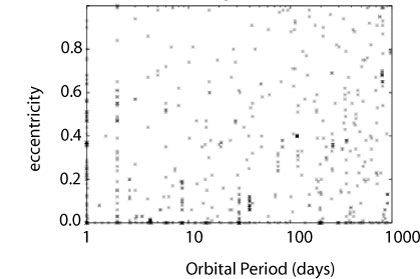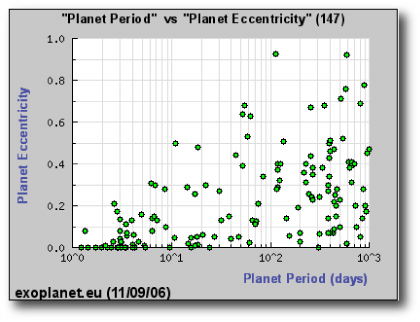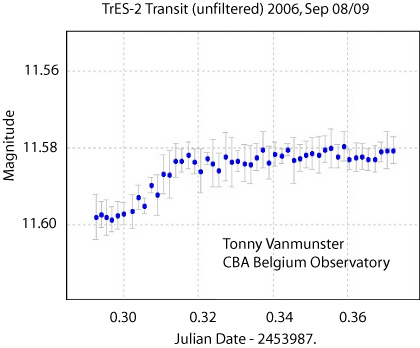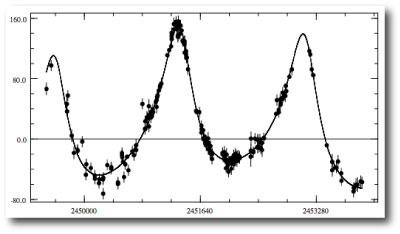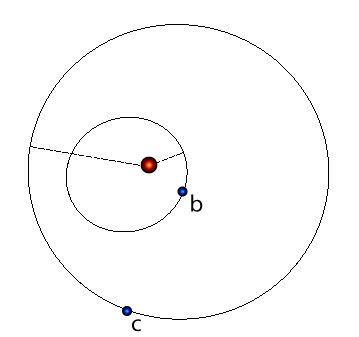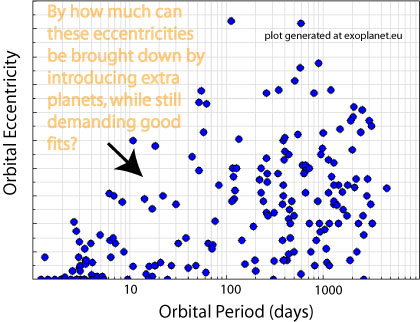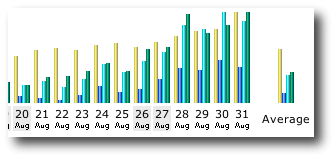
Image Source.
When I teach Astronomy 101, I like to brag about my weight early and often during the class. For example, when I introduce the concept of energy, I’ll tell the students, “Let’s say you have a guy like me. You know, six foot three, 285 lbs (129 kg)… pause… If I’m running down the street at 9 meters per second, then my kinetic energy is 10,449 Joules.”
The first time that I floss my weight, there’s usually a slight rustle through the lecture hall, but generally nobody says anything. Students in the back row glance up slightly startled from their online poker games, then adjust their hoodies and ante up for the next hand.
As the quarter progresses, I’ll find other opportunities to claim an outrageous heft. “Take me, for example, I weigh 287 lbs… pause… solid muscle.”
Usually, that line finally gets a rise out of someone, “You don’t weigh 287!” they’ll blurt out, “You’re more like 150!”
“Are you challenging me?” I’ll roar, “Anyone want an F on the next exam?” Nervous laughter. Eventually, a few more classes in, everyone just rolls their eyes when I remind them of my outrageously high mass.
Eventually, when I get all the way out to the galactic scale, I reach the topic of dark matter and I can cash in on the long set-up. “Look at that rotation curve!” I’ll say, “The orbital velocities of the galaxies in this cluster suggest that there’s many times more mass present than we can observe in the form of stars. It’s like [pause] It’s as if some guy who looks like he weighs 160 steps on the scale and it turns out that he actually weighs 285.”
They laugh and the joke works because we’re able to look at a person and make a mental estimate of their mass. When it comes to extrasolar planets, however, judging mass by size has proved to be effectively impossible. If you are in the vicinity of a hot Jupiter, and are able to measure its radius, you’ll have little basis for judging how massive it is. That is, the mass-radius relation for hot Jupiters isn’t a single-valued function, and we don’t know why. Indeed, understanding the radii of the known transiting planets is one of the most currently interesting exoplanet research topics.
I’ve written several oklo posts about the size problem for the short-period extrasolar planets [see here, here, here, here and here]. In a nutshell, within the aggregate of transiting exoplanets that orbit stars bright enough for high-precision follow-up, there’s a full range of size discrepancies. HD 149026 b is much smaller than would be predicted for a standard-issue Jovian planet of its mass and temperature. TrES-1 has a radius that agrees very well with the theoretical predictions. HD 189733 is somewhat on the large side, and HD 209458 b, famously, is much larger than predicted. [In tomorrow’s post, I’ll give an update on the hydrodynamical simulations that we’ve been doing with the goal of eventually sorting out whether HD 209458 b is caught in Cassini state two.]
It’s therefore still a big deal whenever a new transit is discovered in association with a bright parent star. Today, the TrES collaboration, (who bagged TrES-1 back in ’04) are rolling out a new transiting planet — TrES-2.
TrES-2 is a more-or-less standard-issue hot Jupiter. At 1.28 Jupiter masses, it’s a little more massive than the average short-period planet, and its orbital period of 2.47 days is slightly shorter than the 3-day average period exhibited by this class of objects. The TrES-2 parent star is very similar in mass, radius, and temperature to the Sun. It lies in Lyra, and has a V-band magnitude of 11.4 (making it ideal for follow-up observations by amateurs — check out the transitsearch.org ephemeris table here).
Turns out that TrES-2 is on the large side. Our theoretical models predict a radius of 1.07 Jovian radii if the planet has a core, and 1.11 Jovian radii if it is core-free. The measured radius is 1.24 Jovian radii, with a lower error bar of 0.06 Jovian radii. The planet is thus a bit more than 2-sigma larger than the core-free model, and provides evidence that the mechanism responsible for providing extra heat (and expansion) to these planets is a relatively generic and commonplace phenomenon. It’s hard to invoke special purpose explanations for HD 209458 b’s radius when there’s a slew of other transiting planets that suffer a similar bloat.
One reason I like transiting planets is that they can be drawn to scale with their orbits and parent stars. In TrES-2’s case, the geometry looks like this:
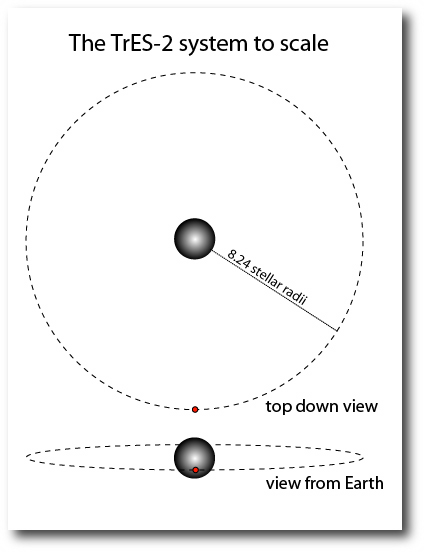
With Illustrator’s scale tool, it’s easy to insert TrES-2 into our planetary police line-up:
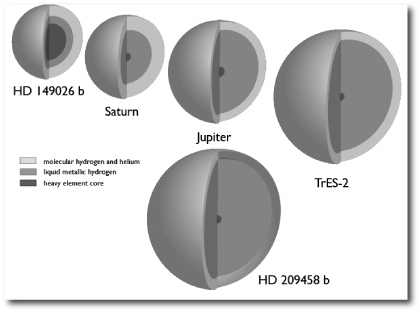
Curiously, the TrES-2 paper makes no mention of the metallicity of the TrES-2 parent star. The metallicity is of great interest because it will allow a test of the Guillot et al. hypothesis that the planetary radii are the result of a concentration mechanism that greatly amplifies the overall solids content of short-period exoplanets that orbit high-metallicity stars. I asked Dave Charbonneau if his team had anything up their sleeve in the metallicity department. He told me that they haven’t had time to get an accurate measurement, and that the number will be released in a follow-up paper.
Amazingly, TrES-2 lies in the field of view of the Kepler Mission. This means that the Kepler satellite will make repeated high-precision measurements of the TrES-2 light curve, with a photometric precision of about one part in 10,000 and a cadence of 15 minutes. This data will allow for very accurate determinations of the durations between transits. By observing small variations in the orbital period, you can detect other bodies in the system, in many cases with masses down into the terrestrial regime. The process by which this is done is highly analagous to the multiparameter fitting process that one uses when running the console, with transit intervals playing an analogous role to the usual radial velocity measurements. Once we get our plate cleared of current console improvements — integrator, bootstrapper, multi-threading, etc. etc., we’ll reconfigure it to enable a look at planet detection via transit timing.

